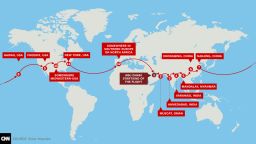Story highlights
Solar Impulse completes first leg of its round-the-world flight, from Abu Dhabi to Oman
Pilot Andre Borschberg was at the controls; Bertrand Piccard will tackle the second journey
After pit stop in Muscat, Oman, the solar-powered plane will travel on to India, Myanmar and China
Solar Impulse 2 has landed safely in Oman on the first leg of its quest to be the first plane to fly around the world fueled only by the sun’s rays.
The solar-powered plane took off from Abu Dhabi in the United Arab Emirates early on Monday with pilot Andre Borschberg at the controls for the 400-kilometer (250 mile) flight.
The journey was expected to take about 12 hours, but high winds of up to 11 knots delayed its landing, forcing Borschberg to fly in a holding pattern above Muscat until they dropped to safe levels.
Once safely on the ground, Borschberg said he was “extremely happy” and “looking forward to the rest of [the] adventure.”
Solar Impulse 2’s visit to Oman is a short pit-stop on its marathon 35,000-kilometer, five month journey across the globe, via India, Myanmar, China and the U.S.
The plane is expected to be on the ground for just eight hours before it takes off again – this time with pilot Bertrand Piccard in charge – bound for Ahmedabad in India.
The potentially historic flight had originally been due to take off on March 1 but its departure was postponed because of concerns about the weather after strong dust storms created hazy conditions.

“We have had a lot of sandstorms in Abu Dhabi, and also a lot of wind, sea breezes, higher than the limit,” said the team’s meteorologist Luc Truellemans in an interview posted on Twitter and YouTube.
By Monday morning, the skies had cleared sufficiently for takeoff, though there was a slight delay while technical checks were carried out, as pilot Andre Borschberg explained on Twitter.
Eventually the plane got off the ground, under the watchful eye of fellow pilot Piccard.
Monday’s journey to Oman was a relatively short one, compared to some of the longer legs, which will take up to five or six days and nights.
Borschberg and Piccard will spend a total of 500 hours behind the controls over the entire trip, taking it in turns in the tiny 3.8-square meter single-seater cockpit.
Before the takeoff, Piccard admitted the pair “had “butterflies in the stomach” at the thought of getting underway after working on the project for so long.
On Sunday, the pair joked about tossing a coin for the right to fly first, before tearfully revealing that they had already decided who would be doing what.
“Andre has worked on this airplane … for 12 years, from the feasibility study until now; it is more than natural that he takes the first step,” said Piccard.
Borschberg added: “Bertrand deserves to fly the last leg, and to make the arrival in Abu Dhabi, completing the vision he created 15 years ago.”
The pair will also split ocean-flying duties: Piccard will take on the five-day, five-night journey across the Pacific, while Borschberg will tackle the Atlantic.
Solar Impulse’s 72-meter (236-foot) wingspan makes it wider than a Boeing 747, but the plane weighs just 2.5 tons, lighter than a large SUV.
The tiny cockpit will be packed with essentials for the journey – enough food and water for a week – as well as a parachute, life raft and oxygen bottles in case of emergencies.
Borschberg and Piccard, who piloted an earlier version of the plane across the U.S. in 2013, are no strangers to adventure. Borschberg is a former fighter pilot, and Piccard was part of the first team to circumnavigate the earth nonstop in a balloon in 1999.
































